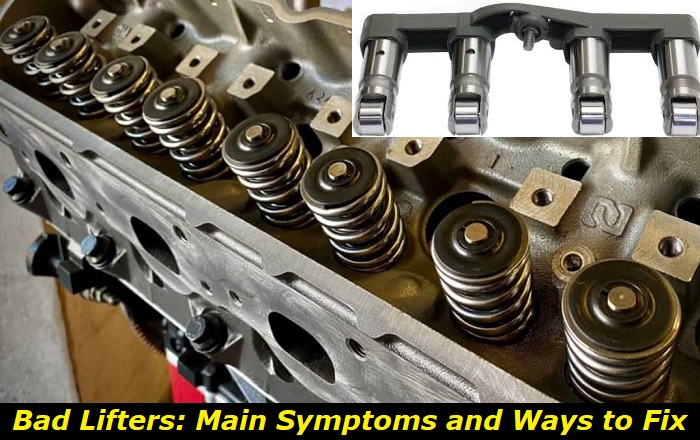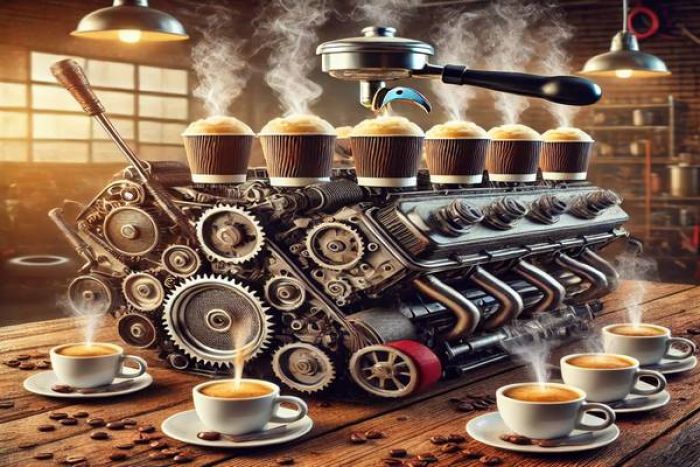While reading and researching about cars, and more specifically, their engines, you have surely come across the term "lifter". Almost every vehicle engine has lifters and like every other part they can wear off as well so you might need to fix or replace them when the time comes.
Basically, a lifter is a cylinder, placed between the vehicle's cylinder valves and the camshaft.
Lifter problems highlights
- Level of importance:Medium
- Commonreasons:Age, poor oil, too high oil viscosity, mileage
- DIY inspection:Almost impossible
- DIY repair:Possible but very complicated
- Price for repair:$450 - $1,200
- Can you drive?Usually, yes
- Ways to fix:In most cases, replacing the lifters will be the only proper choice

There are two kinds of car lifters that we will cover (Hydraulic Lifters and Mechanical Lifters) and give basic information on so that you could have a better understanding of how they work and how they should be fixed and taken care of.
Aside from Hydraulic and Mechanical properties and characteristics, the design of the lifter can be either flat bottom or a roller lifter.
Stick with us to learn more about lifters and ways to fix them down below!
Flat Bottom and Roller Lifter
A flat bottom lifter is coated with specially developed material that can tolerate the persistent pressure of the rotating cam lobe.
The roller lifter, on the other hand, basically converts the energy into a rolling force due to its physical properties and produces less friction and a wider scope of camshaft profiles.
Keep in mind that these designs are present in both hydraulic car lifters and mechanical car lifters. Both types of designs are more than efficient in getting the oil to the upper valve components.
Hydraulic Lifters
Hydraulic lifters were invented back in the 1930s as a solution to the problem that mechanical lifters were producing - too much noise. Also, it's important to note that hydraulic lifters are the most common in today's market.
Hydraulic lifters are made up of a cylindrical body and an internal piston that has limited movement within the body of a lifter. The way the piston works is it basically moves to accommodate thermal growth and component wear.
The piston also maintains the separation of the components and ensures zero valve clearance to maintain quieter engine activity.
The hydraulic lifters have to be adjusted while being installed for the first time and usually do not require further adjustments after that, but there can be exceptions.
The oil inside the lifters helps components work optimally and is usually the most common problem with bad hydraulic lifters and strange engine noises coming from your vehicle's engine.
Mechanical Lifters
These types of lifters are not made in the same way as the hydraulic ones and they do not have a moveable piston within the outer body. They have zero effective loss in camshaft lobe lift. The way mechanical lifters work is that they need some initial thermal growth in the valve train, meaning that the valve lash must be present, at least initially.
Mechanical lifters are usually noisier than their hydraulic counterparts but they make up for it with lower cost and lesser maintenance. They are also more reliable for performance vehicles because they work really well at higher RPMs.
Although you might have mechanical lifters on your vehicle there's a higher chance of it being equipped with hydraulic ones as they are more common on today's market.
Sings of a bad hydraulic lifter
Have you ever heard a ticking or a tapping sound coming from under the hood before? That's usually the first symptom of a bad hydraulic lifter.
The sound is easily distinguishable and if you've never heard it before it might help to know that the sound is very similar to the sound of tapping. Other sounds coming from the engine, like knocks or pings, usually indicate different problems.
This tapping sound will be quick in tempo and can occur after driving for a while or as soon as starting the vehicle. Also, it can occur when the vehicle is both hot or cold depending on the issue that the hydraulic lifter itself is facing.
The most common problem with hydraulic lifters arises due to dirt being accumulated over time and most usually because of low oil pressure. If left unattended, these problems can quickly turn into more damage done to your vehicle. It can harm valve tips, rocker arms, and push rods which are much more expensive than the lifters themselves.
The hydraulic lifter fault may happen due to a plethora of reasons some of which are: lifter spacing issues, low oil pressure, sticking check valve, lack of lubrication, high mileage, clogged engine oil filter, etc...
More signs that you have a bad hydraulic lifter can be:
- Misfires- a bad hydraulic lifter disables the cylinder, and the cylinder is not able to mix and burn air and fuel optimally. Moreover, if the lifters are faulty the exhaust and intake valves will not open properly and it will disrupt the combustion process which results in misfires.
- Dead Cylinder- dead cylinder is a very serious problem it happens when the lifter causes the pushrod to bend and fall out of space. It can induce damage to rocker arms and might even break valves. If you think that you might have a dead cylinder your best bet is to contact a certified car mechanic and have him deal with it.
- Collapsed Lifters- also referred to as "sticky lifters" means that the lifter is incapable of moving and remaining pumped up with oil because of a faulty check valve or a worn-out piston. Moreover, the lifter will fail to maintain oil pressure which will cause the components inside to bash against each other during initial contact. This problem usually leads to the spark plug getting dirty and a faulty cylinder.
Results of a Collapsed Hydraulic Lifter
Being one of the more common problems, if left unattended it can without a doubt lead you to more and more component wear. Mainly, a collapsed or sticky lifter puts a great amount of pressure on the car's valve train which then badly affects the pushrod to the point of it being pushed out of the space between the rocker arm and the top of the lifter.
If the pushrod gets dislocated so to speak the dead cylinder problem is just waiting to happen. Not only this, but collapsed hydraulic lifters can cause problems with rocker arms, valves, heads, and a camshaft as well.
This seemingly common problem can for sure lead to full engine destruction bit by bit so make sure you identify and fix it as soon as you can.
Replacing Collapsed Lifters
If you've figured out that your vehicle has collapsed lifters your best bet is to change them right away. While in some cases you can get away with replacing only the faulty lifters depending on the model of your vehicle, it's always suggested by car manufacturers that you switch them as a set.
If one of the lifters has stopped functioning properly it's usually a good indication that the others will follow soon, so if you opted for replacing them it's usually best to replace all of them and be sure.
Also, it's very important to note that camshafts and flat-tappet lifters are a matched set so when replacing them you must match those.
Generally speaking, the cost of lifters can be anywhere between $5 to $30 but if you are replacing all of them as we do suggest that price may vary depending on the engine itself.
When combining the parts that you have to buy plus the labor rate, the overall price can get a bit hefty.
Of course, if you are a bit of a DIY kind of person, as usual, we have some simple tips and tricks for you to follow.
Ways to Fix Collapsed Lifters
Did you pinpoint your problem to collapsed lifters? Buy new ones and replace them! It's usually not worth your time to physically fix one of the lifters, instead, you should replace the faulty ones with new ones.
Collapsed lifters will come apart when you pull on them, so that's one of the ways you can identify which ones are faulty and which ones you should replace. You will also be able to squeeze the springs on a collapsed lifter, while on the proper one the spring won't allow it.
It is best to replace the lifters as a set, plus the matching cam as we've mentioned above.
The installation process is nothing complicated if you know your way around the engine but can be rather mind-boggling to someone who doesn't understand where the components should go and how they should be mounted.
If you do not have the expertise and knowledge to replace the old lifters and the camshaft you should take your vehicle to a certified car mechanic after you've identified the problem.
The best bet as we've come to understand is to simply replace the collapsed lifters. While this is the best solution to the collapsed lifters problem it pays well to always take care of your vehicle in advance and prevent such issues.
Regular oil changes and lifter spacing adjustment is always good thing to do to prevent hydraulic lifter issues on your vehicle.
Conclusion
Hopefully, we've helped you distinguish the type of lifter problem that you are having as well as some general ideas about how you can fix them.
Some are more easily fixed, and some might require a certified mechanic, but you can always at least identify the problem yourself!
The best bet with collapsed lifters is to replace each of them as a set and buy a matching cam for the same set of lifters. These two need to match, it is very important.
Lastly, if you do not have the knowledge or simply don't feel secure messing with your engine and replacing these components yourself, you can always take your car to a certified car mechanic who will help you out!
Drive safe and keep your car healthy!
About the authors
The CarAraC research team is composed of seasoned auto mechanics and automotive industry professionals, including individuals with advanced degrees and certifications in their field. Our team members boast prestigious credentials, reflecting their extensive knowledge and skills. These qualifications include: IMI: Institute of the Motor Industry, ASE-Certified Master Automobile Technicians; Coventry University, Graduate of MA in Automotive Journalism; Politecnico di Torino, Italy, MS Automotive Engineering; Ss. Cyril and Methodius University in Skopje, Mechanical University in Skopje; TOC Automotive College; DHA Suffa University, Department of Mechanical Engineering






Add comment